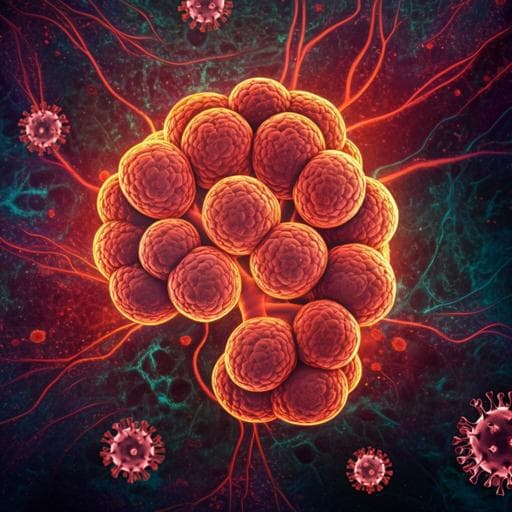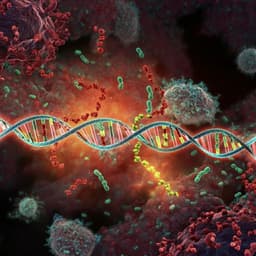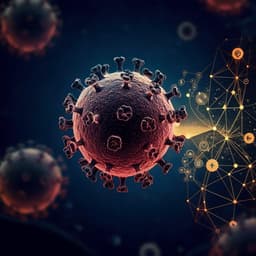
Medicine and Health
Lethality of SARS-CoV-2 infection in K18 human angiotensin-converting enzyme 2 transgenic mice
F. S. Oladunni, J. Park, et al.
The study addresses whether K18 hACE2 transgenic mice, which express human ACE2 under the human cytokeratin 18 promoter, provide a susceptible and lethal small-animal model for SARS-CoV-2 infection and severe COVID-19. Given ACE2 is the entry receptor for SARS-CoV-1 and SARS-CoV-2 and is expressed in respiratory and other tissues, a murine model with appropriate ACE2 expression could enable mechanistic studies and preclinical evaluation of vaccines and antivirals. Prior hACE2 mouse models showed infection with mild-to-moderate disease and no mortality. The authors hypothesized that K18 hACE2 mice would be highly susceptible and could develop lethal disease after intranasal SARS-CoV-2 infection, with infection in respiratory tract and potential CNS involvement, accompanied by cytokine/chemokine dysregulation.
Previous work established hACE2 as the functional receptor for SARS-CoV-1 and SARS-CoV-2 and described widespread ACE2 expression across organs. Multiple hACE2 mouse models using different promoters, or adenoviral hACE2 transduction, supported SARS-CoV-2 replication with variable organ involvement, weight loss, interstitial pneumonia, and serologic responses, but did not exhibit SARS-CoV-2-induced mortality. K18 hACE2 mice were previously lethal for SARS-CoV-1 and have high transgene expression in airway epithelia driven by the K18 promoter. Reports suggested SARS-CoV-2 infection in K18 hACE2 mice, but lethality and full pathogenesis were not established. The need for a validated small-animal model capturing severe outcomes remained, to accelerate evaluation of vaccines and therapeutics.
Design: Comparative infection of K18 hACE2 transgenic mice and WT C57BL/6 controls with SARS-CoV-2 USA-WA1/2020. Outcomes included morbidity (weight), mortality (survival), viral titers in organs, cytokine/chemokine profiling, histopathology, and immunohistochemistry (IHC). Animals: Specific-pathogen-free 4–5-week-old male and female B6.Cg-Tg(K18-ACE2)2Prlmn/J (K18 hACE2) hemizygotes and WT C57BL/6. Housing in ABSL-2 (noninfectious) or ABSL-3 (infection) with ad libitum water and chow. Ethics approvals: Texas Biomed IBC #20-004/#20-010 and IACUC #1708 MU. Virus: SARS-CoV-2 USA-WA1/2020 (GenBank MN985325.1), BEI NR-52281. Master P5 and working P6 stocks generated on Vero E6 at MOI 0.001; titers 1.7×10^6 and 2.6×10^6 PFU/ml. Full-genome NGS confirmed identity and intact furin cleavage site; study virus accession MT576563. Inoculation: Intranasal infection under isoflurane with 1×10^5 PFU SARS-CoV-2 in 50 µl; mock with PBS. Due to limited mice, a single dose was used. Monitoring daily for 14 days; humane endpoint at >25% weight loss. Group sizes: K18 hACE2 morbidity/survival n=14 infected (7F/7M) and n=6 mock (3F/3M). For titers at 2 and 4 DPI: K18 hACE2 n=14 each time (7F/7M); at 6 DPI n=6 (3F/3M). WT C57BL/6: morbidity/survival n=8 infected (4F/4M), n=6 mock (3F/3M); titers at 2 and 4 DPI n=8 per time (4F/4M). Sampling: At 2, 4, 6 DPI, euthanasia and collection of nasal turbinate, trachea, lung, heart, kidney, liver, spleen, small intestine, large intestine, brain. Half fixed in 10% neutral buffered formalin for histology/IHC; half homogenized in PBS for virology and cytokines. Virology: Plaque assays on Vero E6 from tissue homogenate supernatants; limit of detection 10^2 PFU/ml. Immunostaining used cross-reactive anti-SARS-CoV-1 NP mAb 1C7 and peroxidase detection; analysis with CTL ImmunoSpot. Cytokines/Chemokines: Luminex custom 18-plex for inflammatory, TH1/TH2/TH17 cytokines across tissues; IFN-α (type I) and IFN-λ (type III) by ELISA. Time points 2 and 4 DPI; brain also at 6 DPI. Histopathology: H&E on 4 µm sections; blinded evaluation by board-certified veterinary pathologist. Severity scoring in lung and brain across time points. Immunolabeling for CD3 (T cells) and CD20 (B cells). Quantification summarized in Table 3 and Supplementary Table 1. IHC/Confocal: Dual staining for hACE2 (ThermoFisher SN0754) and SARS-CoV NP (cross-reactive) with Permanent Red and Alexa 488, plus DAPI; HIER protocols; imaging on Zeiss LSM 800. Assessed localization in nasal turbinate, lung, brain (including choroid plexus) and colocalization of NP with hACE2. Statistics: GraphPad Prism v8.0. Unpaired two-tailed Student’s t test for group comparisons; one-way/two-way ANOVA with Tukey’s post tests; significance at p<0.05, p<0.005, p<0.0005. Hierarchically clustered Pearson correlations (RStudio, ggplot2, ggcorrplot) among analytes, viral titers, and clinical measures by tissue and time, including sex-stratified analyses.
- Mortality and morbidity: All K18 hACE2 mice infected with 1×10^5 PFU i.n. rapidly lost >20% body weight and succumbed by 6 DPI; WT C57BL/6 infected or mock-infected mice maintained weight and survived the 14-day observation.
- Viral dissemination: In K18 hACE2 mice, at 2 DPI ~10^3 PFU in nasal turbinates and ~10^5 PFU in lungs; lung titers decreased by 4 DPI while nasal turbinate titers were maintained. SARS-CoV-2 was detected in brain at 4 DPI (~5×10^5 PFU) and increased by 6 DPI (~1×10^7 PFU). No virus was detected in other organs. WT C57BL/6 had undetectable titers in all organs at 2 and 4 DPI.
- Chemokine storm: Lungs at 2 DPI showed significant increases in MIP-2/CXCL2, MCP-1/CCL2, MIP-1α/CCL3, MIP-1β/CCL4, RANTES/CCL5, IP-10/CXCL10 versus WT or mock; some remained elevated at 4 DPI (e.g., RANTES/CCL5). Spleen showed increased MIP-2, MIP-1α/β, IP-10 at 2 DPI, with MIP-1α/β persisting at 4 DPI; nasal turbinate exhibited early transient chemokines at 2 DPI. Brain chemokines (MIP-2, IP-10, MIP-1α) rose at 4 DPI and further at 6 DPI.
- Cytokine storm: Lung at 2 DPI displayed mixed inflammatory (TNF, IL-6, IFN-α, IFN-λ), TH1 (IL-12, IFN-γ), TH17 (IL-17, IL-27), and TH2 (IL-4, IL-10) cytokines; IL-1β absent at 2 and 4 DPI. By 4 DPI, most cytokines declined except TNF and type I/III IFNs remained elevated despite ongoing disease. Spleen largely lacked cytokine storm, with TNF increase at 2 DPI. Brain had delayed increase in TH1/TH17 and TH2 cytokines at 4 DPI; IFN-α detected only by 6 DPI; IFN-γ and IFN-λ were generally lower in K18 hACE2 brain vs WT except IFN-γ higher at 6 DPI.
- Sex differences: Minimal in lung; in brain at 4 DPI, males showed higher TH1/TH17 and females higher TH2 cytokines; differences resolved by 6 DPI. Female lungs had higher IP-10 at 2 DPI.
- Correlation clusters: In lung at 2 DPI, two clusters—cytokine cluster centered on IL-10 (correlating with IL-4, IL-6, IL-13, IL-12p70) and chemokine cluster centered on MCP-1/CCL2 (correlating with MIP-1β, MIP-2, MIP-1α, TNF, IFN-γ). Brain at 4–6 DPI showed clusters driven by RANTES/CCL5 and chemokines correlating with TNF/IL-6; some correlations linked to nasal turbinate PFU.
- Pathology: WT mice had minimal transient interstitial pneumonia/rhinitis resolving by 4 DPI, with normal brain. K18 hACE2 mice developed interstitial pneumonia by 2 DPI with alveolar histiocytosis, type II pneumocyte hyperplasia, bronchiolar and endothelial syncytia, and vasculitis; by 4–6 DPI, lung involvement progressed to moderate-marked with hemorrhage, fibrin, edema, and vasculitis. Brain pathology emerged by 4–6 DPI in some mice (meningoencephalitis, vasculitis, necrotic debris). Severity scores increased over time: lungs from minimal/mild (2 DPI) to moderate-marked (6 DPI); brain from normal (2 DPI) to mild-moderate (6 DPI).
- Immune cell infiltration: Lung showed modest and sustained CD3+ T-cell presence with few CD20+ B cells; neutrophils/histiocytes did not markedly accumulate over time. Brain showed increasing CD3+ cells and neutrophils by 4–6 DPI; CD20+ cells were rare.
- Tissue tropism and receptor expression: IHC detected SARS-CoV-2 NP in nasal turbinate, lung, and brain of K18 hACE2 mice with colocalization to hACE2-expressing cells; NP undetectable in WT tissues. High hACE2 expression in airway epithelium and choroid plexus; NP detected in choroid plexus cells and cortical pyramidal neurons, suggesting potential CSF-mediated dissemination to CNS.
- Model significance: K18 hACE2 mice uniquely exhibited rapid, lethal SARS-CoV-2 disease at 10^5 PFU i.n., contrasting with other hACE2 models lacking mortality, highlighting the importance of promoter-driven hACE2 expression in airway epithelium and inoculum dose in determining severe outcomes.
The results confirm that K18 hACE2 transgenic mice are highly susceptible to SARS-CoV-2, developing rapid weight loss, severe pulmonary pathology, CNS infection, and death by 6 DPI. Viral replication initially in upper and lower airways with subsequent high brain titers, alongside pronounced chemokine and early cytokine responses, addresses the hypothesis that this model can recapitulate severe COVID-19 pathogenesis. Colocalization of NP with hACE2 in respiratory epithelium and brain supports receptor-dependent tropism; detection in choroid plexus and cortical neurons suggests routes for neuroinvasion. Compared with other hACE2 models using different promoters or adenoviral transduction, the K18 promoter yields high airway expression likely contributing to lethality, and higher inoculum (10^5 PFU) accelerates disease and CNS involvement. Persistent TNF and type I/III IFNs in lungs and sustained MCP-1/IP-10 likely drive ongoing inflammation, vasculitis, and immune cell recruitment, paralleling human severe COVID-19 signatures. Brain cytokine profiles (TH2-dominant) and reduced interferon signaling may facilitate CNS colonization. The model’s robust, lethal phenotype and measurable endpoints (morbidity, mortality, cytokine/chemokine storms, histopathology, viral loads) make it valuable for evaluating vaccines and therapeutics and for dissecting host factors (e.g., interferon pathways).
This study establishes K18 hACE2 transgenic mice as a lethal small-animal model for SARS-CoV-2 infection that reproduces key features of severe COVID-19, including rapid weight loss, severe pneumonia with vasculitis, CNS infection, and pronounced chemokine/cytokine dysregulation. Viral replication occurs in nasal turbinates, lungs, and brain, with hACE2 expression correlating with tissue tropism. The model’s sensitivity and defined immunopathological endpoints support its use for in vivo assessment of prophylactic vaccines and antiviral therapeutics, and for mechanistic studies of host immune responses and neuroinvasion. Future work should include dose-ranging to determine MLD50, earlier time points to capture initial cytokine kinetics (e.g., IL-1β), exploration of interferon pathway contributions (e.g., crosses with IFNAR knockouts), and testing of candidate interventions to mitigate lung and CNS pathology.
- Limited availability of K18 hACE2 mice constrained group sizes and prevented inclusion of additional time points (e.g., 1 DPI) and dose-ranging to define MLD50.
- Single inoculum dose (1×10^5 PFU) limits generalizability across exposure levels.
- Cytokine/chemokine measurements lacked very early kinetics; resolution at 4 DPI might miss later terminal peaks (5–6 DPI).
- PFU assay detection limits may have missed low-level viral presence in organs with observed pathology (e.g., liver, intestine), where changes may reflect systemic inflammation or microbial translocation.
- Sex-related differences were observed primarily in brain cytokines; broader sex-based analyses were limited by sample sizes.
Related Publications
Explore these studies to deepen your understanding of the subject.







